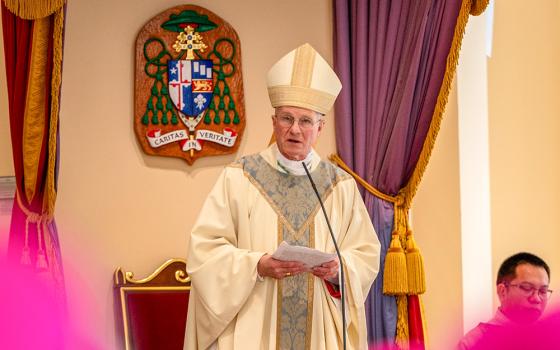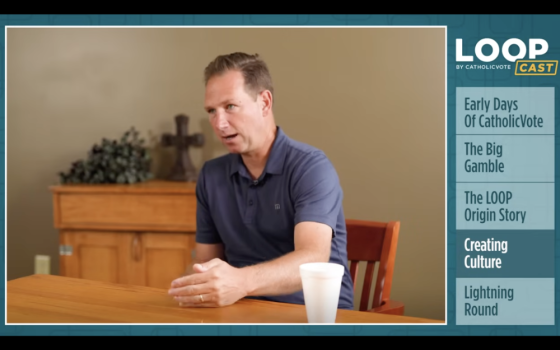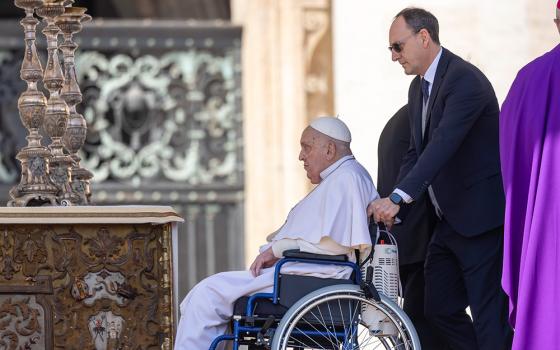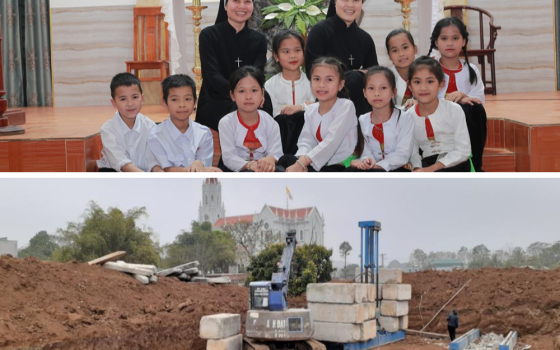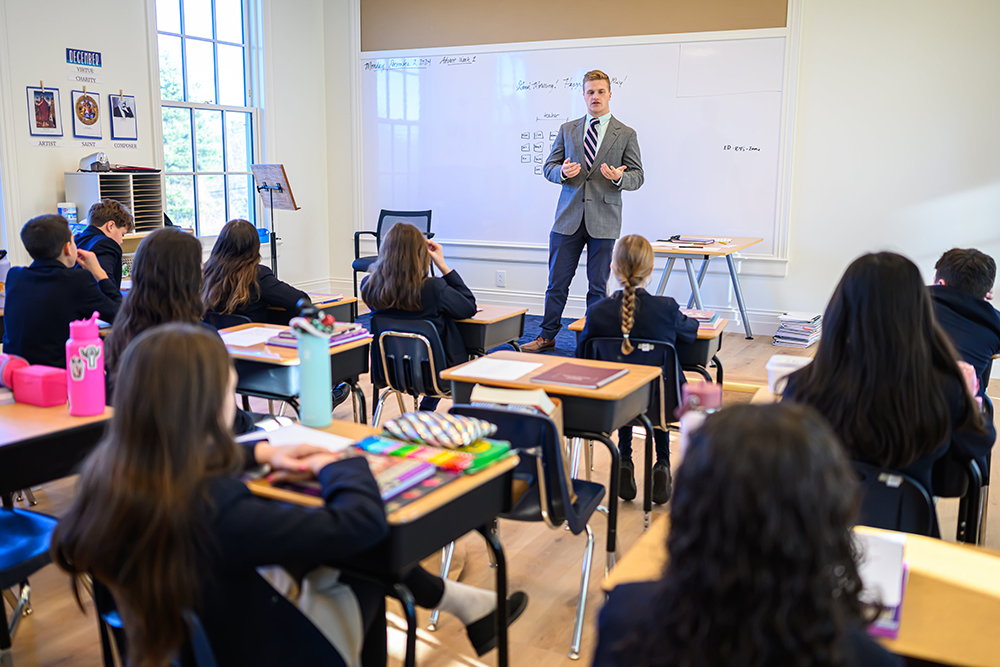
Latin and history teacher Peter Dowdy speaks with a classroom of students at St. Benedict Classical Academy in South Natick, Massachusetts, in this undated photo. (OSV News/Courtesy of Jay Boren)
As we begin a second Trump administration, with the challenges facing our democracy in sharp focus, Jesuit high school theology teachers like us from around the country have been discussing this chapter of American politics and its implications for the classroom.
Admittedly, our conversations have elicited more questions than answers. We agree that we must remain resolute on our Catholic mission to form students into persons with compassionate hearts and the ability to think critically within a politically and ideologically complicated context.
But where can theology educators look for assistance in navigating this political moment effectively and faithfully? Is it possible to teach the Gospel without being political? How should we navigate conflict between our young students, who have little experience disagreeing constructively? How can we adjust our curriculum to address "fake news," misinformation and political protests?
In essence: How do we educate democratically during a Trump presidency?
Advertisement
The predominant mode of instruction in our classrooms is teacher-centered, lecture-based and reduces the students to mere receptacles. This method does not foster independent thinking, the lifeblood of a healthy democracy. Lectures merely reinforce what the current generation of students is already so accustomed to consuming: the perspectives of others, typically in the online agora, without the productive struggle necessary to own opinions for themselves. Too few challenge the truths they are told and too many dismiss truths they disagree with.
Fortunately, there is another way.
The best way to practice being active, independent and reflective thinkers in a democratic society is to have a discussion where students think, speak and listen. Discussion-based learning is an approach that emphasizes active student participation, critical thinking, collaborative exploration and knowledge building. Rather than teachers informing students through the transmission of information, discussion-based educators transform by letting go: teaching students how to work on themselves, with each other and through the material in front of them. We've both used Harkness — a text-based, student-led method developed at Phillips Exeter Academy — to provide scaffolding. But there are others.
The Spiritual Exercises of St. Ignatius of Loyola can also serve as something of a guide for instructors hoping to lead their students into transformation. The Spiritual Exercises operate as a manual for one person, called "the Director," attempting to guide another, "the retreatant," in their spiritual development. Ignatius’ instructions for the director include a reminder in Annotation 15 to "allow [God] to deal directly with [the retreatant], and [the retreatant] to deal directly with God." The director’s task is to construct opportunities for the retreatant to encounter God through their active participation.

(Unsplash/Alexander Grey)
In Ignatian-inspired, discussion-based classrooms, teachers set the context by selecting readings, videos, or concepts for discussion, just as a director would recommend a biblical passage or reflection for a retreatant. The discussion is driven by student action (when they speak) and reflection (when they listen). Each is an opportunity to discover something new. No two conversations are ever the same. Yet students become accustomed to the conversation’s structure, growing in the skills required for meaningful participation and referring to ideas from previous exchanges.
Teachers can rely on practices and strategies to support discussion, such as drafting norms for conversation to remind students of the standards they must meet for a productive discussion. We can equip students to practice thinking for themselves by offering time to journal on provided prompts or assigned texts before opening up a group discussion. Additionally, creating opportunities to share with a peer after completing a writing prompt or annotating a reading allows all students to practice speaking and listening. This tactic is especially helpful for students who have prepared for the discussion but struggle to make their voices heard in large group settings.
We measure what we treasure. Discussions can be evaluated using a rubric that prioritizes "must-haves" of deliberative democracy: adequate preparation beforehand, an ordered discussion with one voice recognized at a time, sustained engagement through body language and eye contact, and marshaling evidence to defend one’s position. Students should assess themselves along these lines, so they learn the difference between a productive conversation and a shouting match. Because, in a democracy, we all have to live with the choices of our peers.
In a democracy, we all have to live with the choices of our peers.
Currently, there is much fear among instructors in our faculty rooms and classrooms. Teachers want to soothe themselves and help the students, so lecturing feels safe and familiar. It also gives us teachers the comforting illusion of control.
But loving our students means creating space for their thoughts (however incomplete) and listening to their perspectives (however challenging). If we love our students enough to let them enter the conversation, we will all arrive at the one thing that has a chance to settle our fears: a renewed sense of community.


